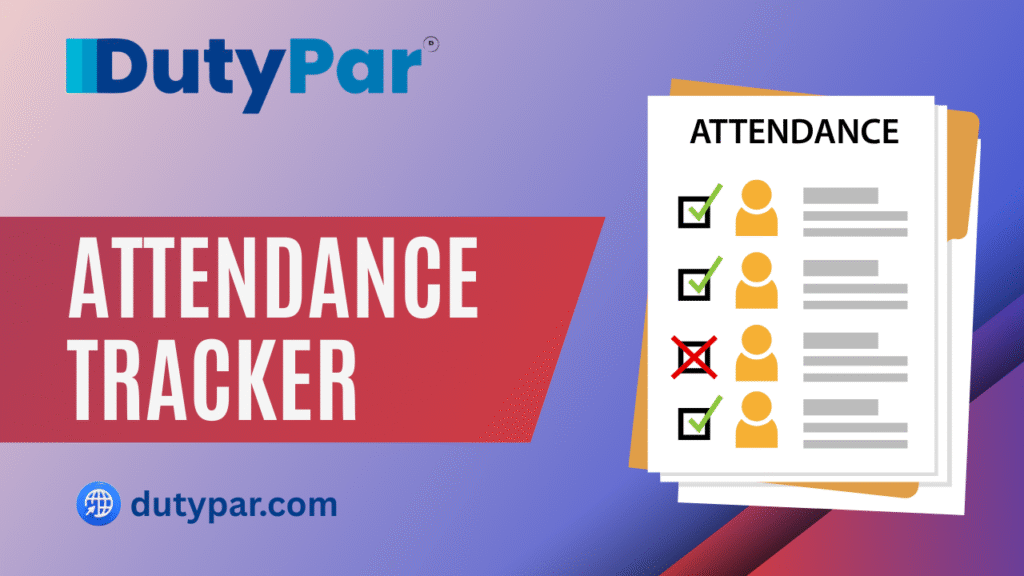
Table of contents
Keeping track of employee attendance used to be a manual, time-consuming task. Today, businesses use smart tools to simplify the process. An Attendance Tracker helps you monitor who’s working, when they arrive, and how long they stay. It improves payroll accuracy, reduces time theft, and boosts team accountability.
In this blog, we’ll explore what an Attendance Tracker is, why it matters, and how to choose the right one. We’ll also share tips to make your tracking system more effective. Whether you run a small business or manage a large team, this guide will help you stay organized and efficient.
What Is an Attendance Tracker?
An Attendance Tracker is a tool or software that records employee work hours. It logs when someone clocks in, takes breaks, and leaves for the day. Some trackers are simple spreadsheets. Others are advanced systems with biometric scanners, mobile apps, and cloud dashboards.
The goal is to keep accurate records of time worked. This helps with payroll, performance reviews, and legal compliance. A good Attendance Tracker also shows patterns—like frequent tardiness or overtime trends—so you can make better decisions.
Why Every Business Needs an Attendance Tracker
Time is money. If you don’t track it well, you lose both. An Attendance Tracker helps you:
- Avoid payroll errors
- Prevent buddy punching and time theft
- Monitor overtime and break times
- Stay compliant with labor laws
- Improve scheduling and shift planning
- Boost employee accountability
Let’s say you run a retail store with 20 employees. Without a tracker, you rely on handwritten logs or verbal updates. Mistakes happen. Someone forgets to clock out. Another claims extra hours. Over time, these errors cost you thousands. An Attendance Tracker solves this by automating the process.
Types of Attendance Trackers
There’s no one-size-fits-all solution. The best Attendance Tracker depends on your business size, budget, and needs. Here are the most common types:
1. Manual Trackers
These include paper sheets or Excel files. They’re cheap but prone to errors. You must enter data by hand and double-check everything.
2. Punch Clocks
Traditional time clocks record when employees punch in or out. Some use swipe cards or PINs. They’re better than manual logs but still allow buddy punching.
3. Biometric Systems
These use fingerprints, facial recognition, or iris scans. They’re highly secure and prevent fraud. Biometric Attendance Trackers are ideal for businesses with strict time policies.
4. Mobile Apps
Employees use their phones to clock in. GPS tracking ensures they’re at the right location. These are great for remote teams or field workers.
5. Cloud-Based Software
These platforms offer dashboards, reports, and integrations with payroll systems. Managers can view attendance in real time. Cloud-based Attendance Trackers are scalable and user-friendly.
Key Features to Look For
Choosing the right Attendance Tracker means looking beyond the basics. Here are features that make a big difference:
- Real-time tracking: See who’s working right now.
- Automated reports: Get weekly or monthly summaries.
- Alerts and notifications: Know when someone is late or absent.
- Integration with payroll: Sync hours with your payment system.
- Mobile access: Let employees clock in from anywhere.
- Security: Protect data with encryption and user controls.
The more features you have, the easier it becomes to manage attendance without stress.
Benefits of Using an Attendance Tracker
Let’s break down the core benefits in a simple table:
| Benefit | Description |
|---|---|
| Payroll Accuracy | Ensures employees are paid for actual hours worked |
| Reduced Time Theft | Prevents buddy punching and false clock-ins |
| Legal Compliance | Keeps records for audits and labor law requirements |
| Improved Scheduling | Helps managers plan shifts based on real attendance data |
| Employee Accountability | Encourages punctuality and transparency |
| Performance Insights | Reveals trends in absenteeism or overtime |
These benefits apply to all industries—from retail and healthcare to construction and tech.
How to Implement an Attendance Tracker
Getting started is easier than you think. Follow these steps:
Step 1: Assess Your Needs
How many employees do you have? Are they remote, on-site, or hybrid? Do you need mobile access or biometric security? Answering these questions helps you choose the right tool.
Step 2: Choose a System
Pick a tracker that fits your workflow. If you manage a small team, a mobile app might be enough. For larger teams, go with cloud-based software that integrates with payroll.
Step 3: Train Your Team
Show employees how to use the system. Keep instructions simple. Offer support during the first few weeks. The smoother the rollout, the better the adoption.
Step 4: Monitor and Adjust
Review attendance data weekly. Look for patterns. Are some employees always late? Is overtime increasing? Use this data to adjust schedules or policies.
Step 5: Stay Transparent
Let your team know why you’re using an Attendance Tracker. Explain how it helps everyone. Transparency builds trust and reduces resistance.
Common Mistakes to Avoid
Even the best Attendance Tracker won’t help if you misuse it. Here are mistakes to avoid:
- Ignoring data: Don’t just collect attendance—analyze it.
- Skipping audits: Review logs regularly to catch errors.
- Not updating policies: Align your attendance rules with the tracker.
- Overcomplicating the system: Keep it simple so everyone can use it.
- Failing to secure data: Protect employee information with strong passwords and encryption.
Avoiding these mistakes keeps your system reliable and fair.
Real-World Example
A logistics company with 150 drivers struggled with late arrivals and missed shifts. They switched from manual logs to a GPS-enabled mobile Attendance Tracker. Drivers clocked in from their phones when they reached the warehouse. Managers received real-time updates.
Within two months:
- Late arrivals dropped by 40%
- Payroll errors fell by 90%
- Shift planning became faster and more accurate
This shows how the right Attendance Tracker can transform operations.
Future of Attendance Tracking
Technology keeps evolving. In the future, Attendance Trackers may use AI to predict absenteeism. Wearable devices could track location and health data. Voice recognition might replace fingerprints. These innovations will make tracking even more seamless.
But no matter how advanced the tools become, the goal stays the same: to ensure fair, accurate, and efficient time management.
Final Thoughts
An Attendance Tracker is more than a time clock. It’s a tool that protects your business, supports your team, and improves operations. Whether you’re managing five employees or five hundred, tracking attendance the right way saves time, money, and stress.
Choose a system that fits your needs. Train your team. Monitor results. And stay open to feedback. When you do, your Attendance Tracker becomes a powerful ally in building a productive and honest workplace.
For Advanced And Professional Attendance Tracking, use DutyPar





